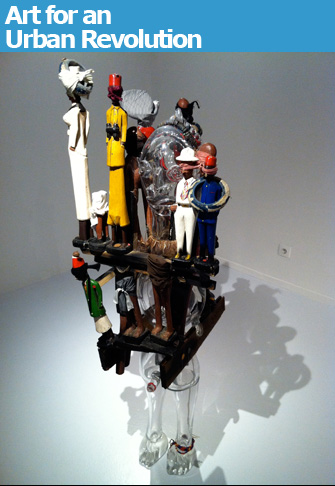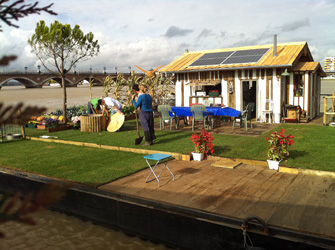 |
|
One of Pascal Marthine Tayou’s “poupées” from his installation at the Musée d’Aquitaine. |
The city of Bordeaux’s biannual citywide contemporary art festival, Evento, took a sociopolitical turn this year under the artistic direction of Italian Arte …
 |
|
One of Pascal Marthine Tayou’s “poupées” from his installation at the Musée d’Aquitaine. |
The city of Bordeaux’s biannual citywide contemporary art festival, Evento, took a sociopolitical turn this year under the artistic direction of Italian Arte Povera artist Michelangelo Pistoletto and his foundation Cittadellarte, who gave it the title L’Art pour une Révolution Urbaine. While the street art – including a number of participative community events in food markets, empty lots, a submarine base built by the Nazis during the Occupation, and along the city’s beautiful waterfront and even on the Garonne (a self-sustaining house and
 |
|
The self-sustaining “House on the Water,” an installation at Evento, is real but temporary and inhabited by actors. |
and mini-farm floating on a platform on the water) – continue only until Oct. 16, some of the exhibitions will remain open for several months.
At the Musée d’Aquitaine, contemporary artists have been invited to react to the history museum’s collection of documents dealing with the slave trade for a show called “This Is How We Came to Eat Sugar?” (through Jan. 23). The standouts here are Pascale Marthine Tayou’s two-room installation featuring his own sculptures, notably his marvelous glass “poupées,” and William Kentridge’s tapestry inspired by the documents, paired with one of his evocative theatrical films on the theme of displaced people.
At the CAPC Museum of Contemporary Art, a team of curators from the Van Abbemuseum in Eindhoven, the Netherlands, has put on a show entitled “Etrange et Proche” (through Feb. 12) on the theme of “voisinage” (neighborly relations), for which Artur Zmijewski has re-enacted the famous Stanford Prison Experiment (in which ordinary people were imprisoned and assigned roles of prisoner or guard), filming the experiment and presenting a replica of the prison itself. Also on show are a number of videos and installations by international artists.
Finally, an installation on the site of the city’s soon-to-be-shut-down slaughterhouse, “Once upon a Future” (through Dec. 18) created by the STEALTH collective, imagines what life in Greater Bordeaux will be like in 2030 when it reaches a projected population of 1 million.
Reader Reaction: Click here to respond to this article (your response may be published on this page and is subject to editing).
More reviews of Paris art shows.
© 2011 Paris Update
Favorite